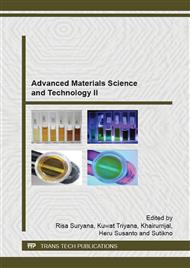p.316
p.325
p.329
p.333
p.338
p.343
p.348
p.352
p.356
The Effect of Sokka Clay on the Tensile and Burning Properties of rPP/Clay Composite
Abstract:
Materials engineering, in order to achieve weight reduction and cost saving, was widely developed using plastic-based composite materials, like polypropylene (PP). As the large consumption of PP, the recycled polypropylene (rPP) was potential for producing rPP-based composites for car body panels. However, it had to have high mechanical and burning properties, and it can be achieved using clay particle as filler, like local clay from Sokka Kebumen Indonesia. The clay particle was made from rejected Sokka tile pocessed using a grinding machine and sieved for several sizes (≤74μm; 74-100 μm; 100-125 µm). The mixure of rPP/clay were pressed using a hotpress for producing the composite and its specimens were tested using Universal Testing Machine and horizontal burning test apparatus, and the fracture surfaces were observed using SEM. The enhancing of tensile and burning properties of rPP/clay composite can be performed by using the addition of Sokka-clay and smaller particle of clay. The rPP/clay composite was competitive with the commercial panel of car interior and potential to be applied as car panel material.
Info:
Periodical:
Pages:
338-342
Citation:
Online since:
August 2015
Authors:
Price:
Сopyright:
© 2015 Trans Tech Publications Ltd. All Rights Reserved
Share:
Citation:


